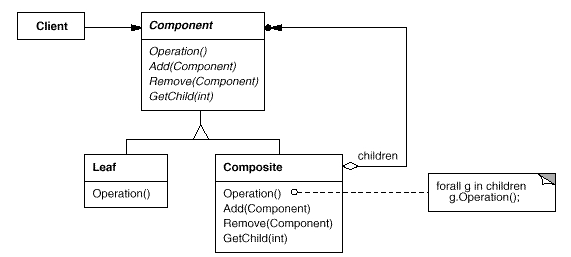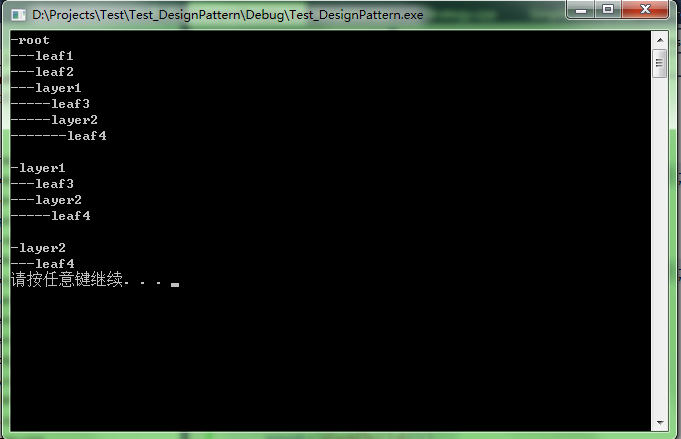组合模式将对象组合成树形结构以表示“部分-整体”的层次结构。C o m p o s i t e 使得用户对单个对象和组合对象的使用具有一致性。
模式图:

适用场景:
- 你想表示对象的部分-整体层次结构。
- 你希望用户忽略组合对象与单个对象的不同,用户将统一地使用组合结构中的所有对象。
举例:
|
1
2
3
4
5
6
7
8
9
10
11
12
13
14
15
16
17
18
19
20
21
22
23
24
25
26
27
28
29
30
31
32
33
34
35
36
37
38
39
40
41
42
43
44
45
46
47
48
49
50
51
52
53
54
55
56
57
58
59
60
61
62
63
64
65
66
67
68
69
70
71
72
73
74
75
76
77
78
79
80
81
82
83
84
85
86
87
88
89
90
91
92
93
94
95
96
97
98
99
100
101
102
103
104
105
106
107
108
109
110
|
namespace FactoryMethod_DesignPattern{ using System; using System.Collections; abstract class Component { protected string strName; public Component(string name) { strName = name; } abstract public void Add(Component c); public abstract void DumpContents(); // other operations for delete, get, etc. } class Composite : Component { private ArrayList ComponentList = new ArrayList(); public Composite(string s) : base(s) {} override public void Add(Component c) { ComponentList.Add(c); } public override void DumpContents() { // First dump the name of this composite node Console.WriteLine("Node: {0}", strName); // Then loop through children, and get then to dump their contents foreach (Component c in ComponentList) { c.DumpContents(); } } } class Leaf : Component { public Leaf(string s) : base(s) {} override public void Add(Component c) { Console.WriteLine("Cannot add to a leaf"); } public override void DumpContents() { Console.WriteLine("Node: {0}", strName); } } /// <summary> /// Summary description for Client. /// </summary> public class Client { Component SetupTree() { // here we have to create a tree structure, // consisting of composites and leafs. Composite root = new Composite("root-composite"); Composite parentcomposite; Composite composite; Leaf leaf; parentcomposite = root; composite = new Composite("first level - first sibling - composite"); parentcomposite.Add(composite); leaf = new Leaf("first level - second sibling - leaf"); parentcomposite.Add(leaf); parentcomposite = composite; composite = new Composite("second level - first sibling - composite"); parentcomposite.Add(composite); composite = new Composite("second level - second sibling - composite"); parentcomposite.Add(composite); // we will leaf the second level - first sibling empty, and start // populating the second level - second sibling parentcomposite = composite; leaf = new Leaf("third level - first sibling - leaf"); parentcomposite.Add(leaf); leaf = new Leaf("third level - second sibling - leaf"); parentcomposite.Add(leaf); composite = new Composite("third level - third sibling - composite"); parentcomposite.Add(composite); return root; } public static int Main(string[] args) { Component component; Client c = new Client(); component = c.SetupTree(); component.DumpContents(); return 0; } }} |
可以看出,Composite类型的对象可以包含其它Component类型的对象。换而言之,Composite类型对象可以含有其它的树枝(Composite)类型或树叶(Leaf)类型的对象。
合成模式的实现根据所实现接口的区别分为两种形式,分别称为安全模式和透明模式。合成模式可以不提供父对象的管理方法,但合成模式必须在合适的地方提供子对象的管理方法(诸如:add、remove、getChild等)。
透明方式
作为第一种选择,在Component里面声明所有的用来管理子类对象的方法,包括add()、remove(),以及getChild()方法。这样做的好处是所有的构件类都有相同的接口。在客户端看来,树叶类对象与合成类对象的区别起码在接口层次上消失了,客户端可以同等同的对待所有的对象。这就是透明形式的合成模式。
这个选择的缺点是不够安全,因为树叶类对象和合成类对象在本质上是有区别的。树叶类对象不可能有下一个层次的对象,因此add()、remove()以及getChild()方法没有意义,是在编译时期不会出错,而只会在运行时期才会出错。
安全方式
第二种选择是在Composite类里面声明所有的用来管理子类对象的方法。这样的做法是安全的做法,因为树叶类型的对象根本就没有管理子类对象的方法,因此,如果客户端对树叶类对象使用这些方法时,程序会在编译时期出错。
这个选择的缺点是不够透明,因为树叶类和合成类将具有不同的接口。
这两个形式各有优缺点,需要根据软件的具体情况做出取舍决定。
安全式的合成模式实现: 只有composite有Add ,remove,delete等方法.
以下示例性代码演示了安全式的合成模式代码:
|
1
2
3
4
5
6
7
8
9
10
11
12
13
14
15
16
17
18
19
20
21
22
23
24
25
26
27
28
29
30
31
32
33
34
35
36
37
38
39
40
41
42
43
44
45
46
47
48
49
50
51
52
53
54
55
56
57
58
59
60
61
62
63
64
65
66
67
68
69
70
71
72
73
74
75
76
77
78
79
80
81
82
83
84
85
86
87
88
89
90
|
// Composite pattern -- Structural example using System;using System.Text;using System.Collections;// "Component"abstract class Component{ // Fields protected string name; // Constructors public Component( string name ) { this.name = name; } // Operation public abstract void Display( int depth );}// "Composite"class Composite : Component{ // Fields private ArrayList children = new ArrayList(); // Constructors public Composite( string name ) : base( name ) {} // Methods public void Add( Component component ) { children.Add( component ); } public void Remove( Component component ) { children.Remove( component ); } public override void Display( int depth ) { Console.WriteLine( new String( '-', depth ) + name ); // Display each of the node's children foreach( Component component in children ) component.Display( depth + 2 ); }}// "Leaf"class Leaf : Component{ // Constructors public Leaf( string name ) : base( name ) {} // Methods public override void Display( int depth ) { Console.WriteLine( new String( '-', depth ) + name ); }}/// <summary>/// Client test/// </summary>public class Client{ public static void Main( string[] args ) { // Create a tree structure Composite root = new Composite( "root" ); root.Add( new Leaf( "Leaf A" )); root.Add( new Leaf( "Leaf B" )); Composite comp = new Composite( "Composite X" ); comp.Add( new Leaf( "Leaf XA" ) ); comp.Add( new Leaf( "Leaf XB" ) ); root.Add( comp ); root.Add( new Leaf( "Leaf C" )); // Add and remove a leaf Leaf l = new Leaf( "Leaf D" ); root.Add( l ); root.Remove( l ); // Recursively display nodes root.Display( 1 ); }} |
透明式的合成模式实现: 每个里都有add,remove等修改方法.
以下示例性代码演示了安全式的合成模式代码:
|
1
2
3
4
5
6
7
8
9
10
11
12
13
14
15
16
17
18
19
20
21
22
23
24
25
26
27
28
29
30
31
32
33
34
35
36
37
38
39
40
41
42
43
44
45
46
47
48
49
50
51
52
53
54
55
56
57
58
59
60
61
62
63
64
65
66
67
68
69
70
71
72
73
74
75
76
77
78
79
80
81
82
83
84
85
86
87
88
89
90
91
92
93
|
// Composite pattern -- Structural example using System;using System.Text;using System.Collections;// "Component"abstract class Component{ // Fields protected string name; // Constructors public Component( string name ) { this.name = name; } // Methods abstract public void Add(Component c); abstract public void Remove( Component c ); abstract public void Display( int depth );}// "Composite"class Composite : Component{ // Fields private ArrayList children = new ArrayList(); // Constructors public Composite( string name ) : base( name ) {} // Methods public override void Add( Component component ) { children.Add( component ); } public override void Remove( Component component ) { children.Remove( component ); } public override void Display( int depth ) { Console.WriteLine( new String( '-', depth ) + name ); // Display each of the node's children foreach( Component component in children ) component.Display( depth + 2 ); }}// "Leaf"class Leaf : Component{ // Constructors public Leaf( string name ) : base( name ) {} // Methods public override void Add( Component c ) { Console.WriteLine("Cannot add to a leaf"); } public override void Remove( Component c ) { Console.WriteLine("Cannot remove from a leaf"); } public override void Display( int depth ) { Console.WriteLine( new String( '-', depth ) + name ); }}/// <summary>/// Client test/// </summary>public class Client{ public static void Main( string[] args ) { // Create a tree structure Composite root = new Composite( "root" ); root.Add( new Leaf( "Leaf A" )); root.Add( new Leaf( "Leaf B" )); Composite comp = new Composite( "Composite X" ); comp.Add( new Leaf( "Leaf XA" ) ); comp.Add( new Leaf( "Leaf XB" ) ); root.Add( comp ); root.Add( new Leaf( "Leaf C" )); // Add and remove a leaf Leaf l = new Leaf( "Leaf D" ); root.Add( l ); root.Remove( l ); // Recursively display nodes root.Display( 1 ); }} |
实例
再看看一个完整些的例子:
|
1
2
3
4
5
6
7
8
9
10
11
12
13
14
15
16
17
18
19
20
21
22
23
24
25
26
27
28
29
30
31
32
33
34
35
36
37
38
39
40
41
42
43
44
45
46
47
48
49
50
51
52
53
54
55
56
57
58
59
60
61
62
63
64
65
66
67
68
69
70
71
72
73
74
75
76
77
78
79
80
81
82
83
84
85
86
87
88
89
90
91
92
93
94
95
96
97
98
99
100
101
102
103
|
#include <iostream> #include <string> #include <list> using namespace std; class Component { protected: string name; public: Component(string name) :name(name) { } virtual void AddComponent(Component *component) { } virtual void RemoveComponent(Component *component) { } virtual void GetChild(int depth) { } }; class Leaf: public Component { public: Leaf(string name) :Component(name) { } void AddComponent(Component *component) { cout<<"Leaf can't add component"<<endl; } void RemoveComponent(Component *component) { cout<<"Leaf can't remove component"<<endl; } void GetChild(int depth) { string _tmpstring(depth, '-'); cout<<_tmpstring<<name<<endl; } }; class Composite:public Component { private: list<Component*> _componets; public: Composite(string name) :Component(name) { } void AddComponent(Component *component) { _componets.push_back(component); } void RemoveComponent(Component *component) { _componets.remove(component); } void GetChild(int depth) { string tmpstring (depth, '-'); cout<<tmpstring<<name<<endl; list<Component*>::iterator iter = _componets.begin(); for(; iter != _componets.end(); iter++) { (*iter)->GetChild(depth + 2); } } }; int main() { Composite *root = new Composite("root"); Leaf *leaf1 = new Leaf("leaf1"); Leaf *leaf2 = new Leaf("leaf2"); root->AddComponent(leaf1); root->AddComponent(leaf2); Composite *lay2 = new Composite("layer2"); Leaf *leaf4 = new Leaf("leaf4"); lay2->AddComponent(leaf4); Composite *lay1 = new Composite("layer1"); Leaf *leaf3 = new Leaf("leaf3"); lay1->AddComponent(leaf3); lay1->AddComponent(lay2); root->AddComponent(lay1); root->GetChild(1); cout<<endl; lay1->GetChild(1); cout<<endl; lay2->GetChild(1); delete root; delete lay1; delete lay2; delete leaf1; delete leaf2; delete leaf3; delete leaf4; system("pause"); return 0; } |
输出:















